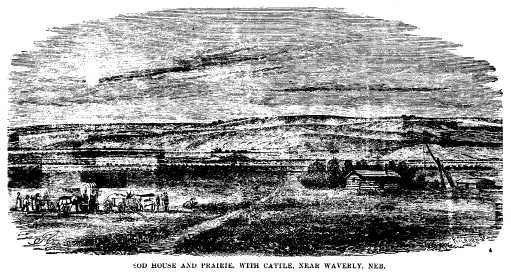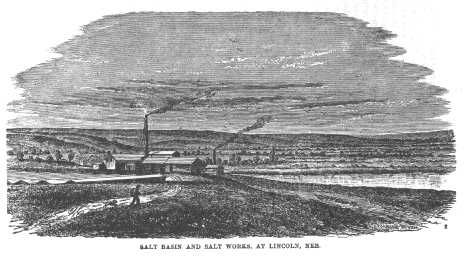

When several Roman Princes consulted the Delphic oracle, they were told that he of them who first kissed his mother, should become King of Rome. Thereupon one of them, Brutus, fell down and kissed the earth. The oracle was fulfilled when Brutus became the foremost Roman. Homesteaders kiss that same mother, and are on the way to become more than Roman Kings.
A majority of homesteaders are men of family. Some of them enter Nebraska, bringing their wives and children in their own wagons, lodging on the way, and for awhile on their farms in those wagons.
If they have money they buy, at the nearest railroad station, lumber for house-building, already so far manufactured that they need no carpenter to set up their dwellings. But poorer men throw up sod-houses. The green sward turned up by the breaking plow is so "matted and massed together" as to form better brick than the Hebrews turned out for Pharaoh, even before he denied them straw. Out of this material, and with no tool but a spade, many a man by ten days' labor has completed a house, roof and all, (15 x 15 feet inside) - a Nebraska "brown front" - both warmer in winter and cooler in summer than any house which can be made of lumber. Doors and windows are for sale in all stores, and trees alongside every brook afford rafters.
Many pioneers leave their families in the old home until they have prepared the new one. Few can leave their farms and go for them, but westward trains are full of wives carrying children to their husbands. Sixteen babies have been counted in a single car on this pilgrimage - Japhets in search of their Fathers.
But while most pioneers drop many a comfort on their long march, some Yankees are shrewd enough to go west, and yet not go out. A Massachusetts man chartered a freight car, on Cape Ann, put on board his household stuff, provisions, wife and children, and traveled without change to Nebraska, keeping house all the time till he and his were landed at the nearest station to Plymouth colony.
The rapidity of settlement has been largely owing to the recent extension of railroads through these land districts. But those roads could not have thus developed the country, had they not run on the parallel along which settlement naturally flows. Had their lines been far north or south, population would have been no more increased by them than the entrance fees exacted at the gates of Florence were, when a stupid duke thought to double his revenue by doubling the
Regarding matters
The following extract from the United States Land Office reports shows the comparative progress of the two States, from the year when Nebraska was admitted into the Union, down to the latest official statistics:
The acres entered as Homesteads were MINNESOTA. NEBRASKA.
|
for the year ending June 30, 1868, |
|
|
|
|
|
1869, |
|
|
|
|
1870, |
|
|
|
|
1871, |
|
|
|
|
|
|
|
Thus in four successive years the homesteads taken in Nebraska exceeded those taken in Minnesota by well nigh three hundred and fifty thousand acres, or in exact figures, 345,151.
During the same four years, the public lands sold for cash in Minnesota amounted to 487,163 acres, those sold in Nebraska to 1,037,002 acres - that is to more than twice as many.
During the same four years the public lands disposed of for cash, scrip and homesteads, in Minnesota, amounted to 2,323,310 acres - those thus disposed of in Nebraska to 3,448,379 acres. Within that period, then, agricultural settlement spread over 1,125,069 more acres in Nebraska than in Minnesota - or forty per cent. more.
The United States Land Office report for 1872 has not yet appeared. It is hence impossible to compare the respective acreages disposed of during that year, in Nebraska and in Minnesota, by the government. But could such a comparison be made, it would probably turn out in favor of Nebraska. One proof is that the aggregate number of homesteaders and pre-emptors who, from the opening of the offices up to the close of last autumn, had filed claims in the four Minnesota offices nearest the line of the Northern Pacific railroad, fell short of the number of such claims filed in a single Nebraska office, namely, Lincoln. In the Minnesota offices at Alexandria, Duluth, Oak Lake and St. Cloud, the homestead filings amounted to 11,323, those in Lincoln to 12,304. In the four Minnesota offices, the pre-emptions were 11,847, in Lincoln they were 13,447. The Minnesota total was 23,170, the Lincoln total 25,751.
No populational meter is at hand for Minnesota, but for Nebraska one presents itself in the ratio of school children to population, which ratio may fairly be judged the same in one year as in another.
In 1870, the Nebraska school-children were 32,762, and the population by the United States census, was 122,993. In 1872 the school-children had increased to 51,123, and therefore the inhabitants could not be computed by any of those children who had reached the Rule of Three, at less than 191,928 - an increase in two years of 68,935, or 56 per cent.
The lists of school-children, besides showing the growth of the State at large, are a meter of local progress in all quarters. Look, for instance, along the main line of the Burlington & Missouri River Railroad. It runs through eight counties: Adams, Cass, Clay, Fillmore, Kearney, Lancaster, Saline and Saunders. Their school-children in 1870 were 5,912, and their population 23,247. In 1872 their school-children. had multiplied to 11,210, therefore their population then cannot have been less than 44,079 5/8.
Nebraska, at large, has been exceptionally prosperous, for, judging by the increase of school-children, its populational increment in two years has been 56.04 per cent. But even this percentage falls far below that of the eight counties traversed by the B. & M. railroad line. Their populational advance, between 1870 and 1872, has been at the rate of 89.6 per cent.
In the next two years their growth will be still greater than in the last two, for half of them had no school-children two years ago, and locomotives not yet having traversed them all for more than six months, have but just began to put forth their magical influences in making solitudes populous.

© 1998, 1999, 2000, 2001 for the NEGenWeb Project by T& C Miller